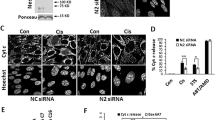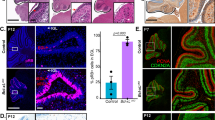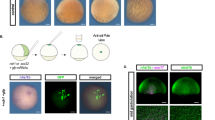Abstract
Although the role of the b-cell lymphoma (Bcl)-2 family of apoptosis inhibitors is well documented in tumor cells and tissue morphogenesis, their role during the early development of vertebrates is unknown. Here, we characterize Nrz, a new Bcl-2-related inhibitor of apoptosis in zebrafish. Nrz is a mitochondrial protein, antagonizing the death-accelerator Bax. The nrz gene is mainly expressed during gastrulation and somitogenesis. The knockdown of nrz with antisense morpholinos leads to alterations of the somites, correlated with an increase in apoptosis. In addition, earlier during development, in the zebrafish gastrula, nrz knockdown results in an increase of snail-1 expression at the margin and frequent gastrulation arrest at the shield stage, independently of apoptosis. Together these data suggest that Nrz, in addition to its effect on apoptosis, contributes to cell movements during gastrulation by negatively regulating the expression of Snail-1, a transcription factor that controls cell adhesion.
Similar content being viewed by others
Log in or create a free account to read this content
Gain free access to this article, as well as selected content from this journal and more on nature.com
or
Abbreviations
- BCL:
-
b-cell lymphoma
- BH-3:
-
bcl-2 homology domain 3
- DMEM:
-
Dulbecco's minimal essential medium
- EMT:
-
epithelial mesenchymal transition
- E-YSL:
-
external yolk syncitial layer
- FITC:
-
fluoresceine isothiocyanate
- HPF:
-
hours post fertilization
- HVT:
-
herpes virus of turkeys
- I-YSL:
-
internal yolk syncitial layer
- MO:
-
morpholino
- NR-13:
-
neuroretina clone 13
- ORF:
-
open reading frame
- PBS:
-
phosphate buffer saline
- PCD:
-
programmed cell death
- RT-PCR:
-
reverse transcriptase-polymerase chain reaction
- TGF:
-
transforming growth factor
- TM:
-
transmembrane domain
- YSL:
-
yolk syncitial layer
References
Hengartner MO (1999) Programmed cell death in the nematode C. elegans. Recent Prog. Horm. Res. 54: 213–222
Ranger AM, Malynn BA and Korsmeyer SJ (2001) Mouse models of cell death. Nat. Genet. 28: 113–118
Reed JC (2003) Apoptosis-targeted therapies for cancer. Cancer Cell 3: 17–22
Scorrano L and Korsmeyer SJ (2003) Mechanisms of cytochrome c release by proapoptotic BCL-2 family members. Biochem. Biophys. Res. Commun. 304: 437–444
Gross A, McDonnell JM and Korsmeyer SJ (1999) BCL-2 family members and the mitochondria in apoptosis. Genes Dev. 13: 1899–1911
Moreau C, Cartron PF, Hunt A, Meflah K, Green DR, Evan G, Vallette FM and Juin P (2003) Minimal BH3 peptides promote cell death by antagonizing anti-apoptotic proteins. J. Biol. Chem. 278: 19426–19435
Bonnefoy-Berard N, Aouacheria A, Verschelde C, Quemeneur L, Marcais A and Marvel J (2004) Control of proliferation by Bcl-2 family members. Biochim. Biophys. Acta 1644: 159–168
Inohara N and Nunez G (2000) Genes with homology to mammalian apoptosis regulators identified in zebrafish. Cell Death Differ. 7: 509–510
Pichler FB, Laurenson S, Williams LC, Dodd A, Copp BR and Love DR (2003) Chemical discovery and global gene expression analysis in zebrafish. Nat. Biotechnol. 21: 879–883
Gillet G, Guerin M, Trembleau A and Brun G (1995) A Bcl-2-related gene is activated in avian cells transformed by the Rous sarcoma virus. EMBO J. 14: 1372–1381
Locascio A, Manzanares M, Blanco MJ and Nieto MA (2002) Modularity and reshuffling of Snail and Slug expression during vertebrate evolution. Proc. Natl. Acad. Sci. USA 99: 16841–16846
Aouacheria A, Arnaud E, Venet S, Lalle P, Gouy M, Rigal D and Gillet G (2001) Nrh, a human homologue of Nr-13 associates with Bcl-Xs and is an inhibitor of apoptosis. Oncogene 20: 5846–5855
Ke N, Godzik A and Reed JC (2001) Bcl-B, a novel Bcl-2 family member that differentially binds and regulates Bax and Bak. J. Biol. Chem. 276: 12481–12484
Inohara N, Gourley T, Carrio R, Muniz M, Merino J, Garcia I, Koseki T, Hu Y, Chen S and Nunez G (1998) Diva, a Bcl-2 homologue that binds directly to Apaf-1 and induces BH3-independent cell death. J. Biol. Chem. 273: 32479–32486
Song Q, Kuang Y, Dixit VM and Vincenz C (1999) Boo, a novel negative regulator of cell death, interacts with Apaf-1. EMBO J. 18: 167–178
Green DR and Kroemer G (2004) The pathophysiology of mitochondrial cell death. Science 305: 626–629
Ikegami R, Hunter P and Yager TD (1999) Developmental activation of the capability to undergo checkpoint-induced apoptosis in the early zebrafish embryo. Dev. Biol. 209: 409–433
Nieto MA (2002) The snail superfamily of zinc-finger transcription factors. Nat. Rev. Mol. Cell Biol. 3: 155–166
Thisse C, Thisse B, Schilling TF and Postlethwait JH (1993) Structure of the zebrafish snail1 gene and its expression in wild-type, spadetail and no tail mutant embryos. Development 119: 1203–1215
Hammerschmidt M and Nusslein-Volhard C (1993) The expression of a zebrafish gene homologous to Drosophila snail suggests a conserved function in invertebrate and vertebrate gastrulation. Development 119: 1107–1118
Timmerman LA, Grego-Bessa J, Raya A, Bertran E, Perez-Pommares JM, Diez J, Aranda S, Palomo S, McCormick F, Izpisua-Belmonte JC and de la Pompa JL (2004) Notch promotes epithelial–mesenchymal transition during cardiac development and oncogenic transformation. Genes Dev. 18: 99–115
Peinado H, Quintanilla M and Cano A (2003) Transforming growth factor beta-1 induces snail transcription factor in epithelial cell lines: mechanisms for epithelial mesenchymal transitions. J. Biol. Chem. 278: 21113–21123
Solnica-Krezel L and Driever W (1994) Microtubule arrays of the zebrafish yolk cell: organization and function during epiboly. Development 120: 2443–2455
Jiao J, Huang X, Feit-Leithman RA, Neve RL, Snider W, Dartt DA and Chen DF (2005) Bcl-2 enhances Ca(2+) signaling to support the intrinsic regenerative capacity of CNS axons. EMBO J. 24: 1068–1078
Sorenson CM (2004) Interaction of bcl-2 with Paxillin through its BH4 domain is important during ureteric bud branching. J. Biol. Chem. 279: 11368–11374
Reed JC (1998) Bcl-2 family proteins. Oncogene 17: 3225–3236
Hemavathy K, Ashraf SI and Ip YT (2000) Snail/slug family of repressors: slowly going into the fast lane of development and cancer. Gene 257: 1–12
Seki K, Fujimori T, Savagner P, Hata A, Aikawa T, Ogata N, Nabeshima Y and Kaechoong L (2003) Mouse Snail family transcription repressors regulate chondrocyte, extracellular matrix, type II collagen and aggrecan. J. Biol. Chem. 278: 41862–41870
Ettensohn CA (1999) Cell movements in the sea urchin embryo. Curr. Opin. Genet. Dev. 9: 461–465
Kinkel MD and Horton Jr WE (2003) Coordinate down-regulation of cartilage matrix gene expression in Bcl-2 deficient chondrocytes is associated with decreased SOX9 expression and decreased mRNA stability. J. Cell Biochem. 88: 941–953
Li L, Backer J, Wong AS, Schwanke EL, Stewart BG and Pasdar M (2003) Bcl-2 expression decreases cadherin-mediated cell–cell adhesion. J. Cell Sci. 116: 3687–3700
Kane DA, McFarland KN and Warga RM (2005) Mutations in half baked/E-cadherin block cell behaviors that are necessary for teleost epiboly. Development 132: 1105–1116
Yamamoto A, Amacher SL, Kim SH, Geissert D, Kimmel CB and De Robertis EM (1998) Zebrafish paraxial protocadherin is a downstream target of spadetail involved in morphogenesis of gastrula mesoderm. Development 125: 3389–3397
Westerfield M (2000) The Zebrafish Book (Eugene, OR: University of Oregon Press)
Williams JA, Barrios A, Gatchalian C, Rubin L, Wilson SW and Holder N (2000) Programmed cell death in zebrafish rohon beard neurons is influenced by TrkC1/NT-3 signaling. Dev. Biol. 226: 220–230
Moradi-Ameli M, Lorca T, Ficheux D, Di Pietro A and Gillet G (2002) Interaction between the antiapoptotic protein Nr-13 and cytochrome c. Antagonistic effect of the BH3 domain of Bax. Biochemistry 41: 8540–8550
Aouacheria A, Ory S, Schmitt JR, Rigal D, Jurdic P and Gillet G (2002) p60(v-src) and serum control cell shape and apoptosis via distinct pathways in quail neuroretina cells. Oncogene 21: 1171–1186
Acknowledgements
Many thanks to L Bernard for organizing the zebrafish facilities. We thank J Gouttenoire, F Mallein-Gerin and P Blader for help and comments. B Thisse and A Yamamoto are acknowledged for zebrafish probes. This work was supported by Retina France, the ARC, the région Rhône-Alpes and the CNRS. EA was supported by the Ligue nationale contre le cancer (comité de Haute Savoie). AA was supported by the CNRS and the FRM. KFF was supported by the région Rhône-Alpes and EMBO.
Author information
Authors and Affiliations
Corresponding author
Additional information
Edited by A Villunger
Supplementary Information accompanies the paper on Cell Death and Differentiation website (http://www.nature.com/cdd)
Rights and permissions
About this article
Cite this article
Arnaud, E., Ferri, K., Thibaut, J. et al. The zebrafish bcl-2 homologue Nrz controls development during somitogenesis and gastrulation via apoptosis-dependent and -independent mechanisms. Cell Death Differ 13, 1128–1137 (2006). https://doi.org/10.1038/sj.cdd.4401797
Received:
Revised:
Accepted:
Published:
Issue date:
DOI: https://doi.org/10.1038/sj.cdd.4401797
Keywords
This article is cited by
-
A structural investigation of NRZ mediated apoptosis regulation in zebrafish
Cell Death & Disease (2018)
-
Bcl-wav and the mitochondrial calcium uniporter drive gastrula morphogenesis in zebrafish
Nature Communications (2013)
-
The selective BH4-domain biology of Bcl-2-family members: IP3Rs and beyond
Cellular and Molecular Life Sciences (2013)
-
Diva/BclB regulates differentiation by inhibiting NDPKB/Nm23H2-mediated neuronal differentiation in PC-12 cells
BMC Neuroscience (2012)
-
Pre-gastrula expression of zebrafish extraembryonic genes
BMC Developmental Biology (2010)



